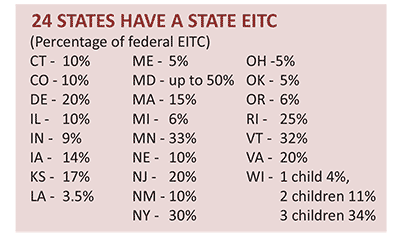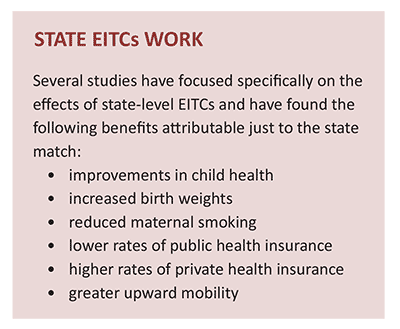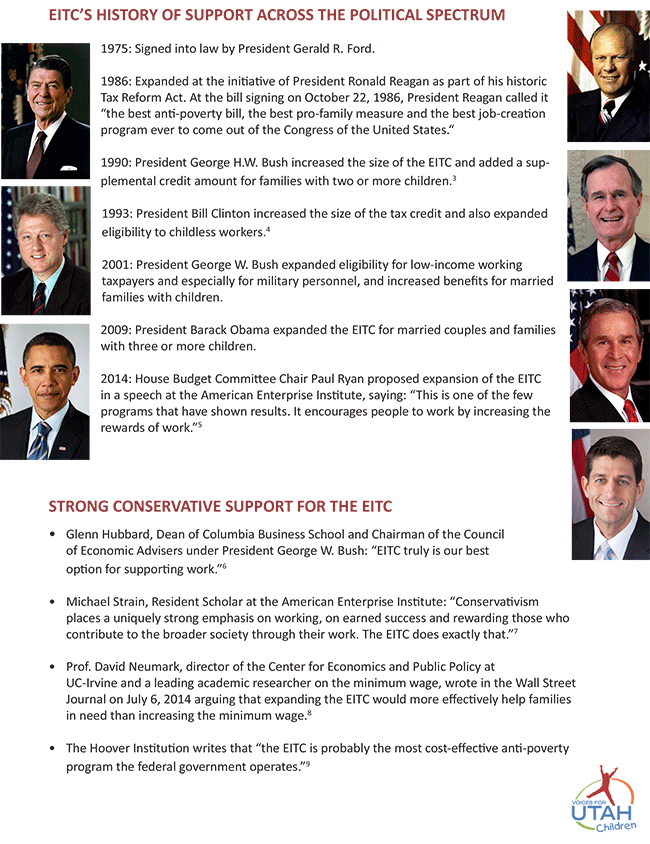The Earned Income Tax Credit is a federal tax credit for low- and moderate income families that encourages and rewards work. The credit was created in 1975 under President Ford. Because of its remarkable ability to reduce poverty and promote family health and self-sufficiency, it has been expanded since then by President Reagan and all subsequent presidents.
Only families that earn income through work qualify for the EITC. By off setting federal income and payroll taxes these families pay, the EITC lifts over 6 million Americans (and over 70,000 Utahns)
out of poverty every year. Since its creation in 1975, the EITC has been among the most studied federal anti-poverty initiatives. Dozens of academic studies looking at recipients across the nation and over time have found enormous beneficial effects for both parents and their children.

For parents, the EITC’s empirically demonstrated effects include:
• increased employment
• increased earnings from work
• reduced maternal smoking
• increased retirement security in later years, especially for single mothers
For children, the EITC’s benefits include:
• improved child and maternal health
• better K-12 school achievement
• increased future earnings when these children grow up and enter the workforce
• increased intergenerational social mobility
For the entire family, the EITC’s impacts include:
• reduced poverty
• lower rates of public health insurance
• higher rates of private health insurance
A list of academic studies and their findings is available from Voices for Utah Children.
State EITCs Offset Regressive Effects of Income, Sales and Property Taxes

Twenty-four states have created state EITCs to supplement and enhance the impact of the federal program. State EITCs work similarly to and leverage the federal EITC. States rely
heavily on taxes like sales, gas and property taxes, which hit lower-income families harder (as a share of income) than wealthier ones. State EITCs reduce the taxes paid by these
working families, allowing them to keep more of what they earn.
Working families with children earning up to $39,000 to $52,000 (depending on marital status and the number of children) generally can qualify for a state EITC, but the largest benefits go to families with annual incomes between about $10,000 and $23,000.
An Innovative Proposal: Using a State EITC to Promote College Savings and Incent Post-Secondary Education in Utah

An innovative proposal under discussion for Utah combines two key elements proven to reduce intergenerational poverty:
• Tax credit equal to 5% of the federal EITC, which means a maximum credit of about $300
• State match up to $100 for filers who deposit their credit into the Utah Educational Savings Plan.
One study cited by the Aspen Institute documents that low- and moderate-income children with dedicated college savings as small as $1-$499 are three times more likely to attend college and four
times more likely to graduate from college than those without.2 Such a hybrid program could allow Utah to benefit from the combined effects of these two ideas that have proven so effective when applied separately.
The EITC Has Bipartisan Support

Federal EITC Facts for Utah
The federal Earned Income Tax Credit was created under President Ford and expanded under Presidents Reagan, Bush, and all subsequent presidents.
• 193,551 Utah households received the federal EITC for 2013, about 18% of tax filers.
• Utah’s EITC households include 218,500 workers and 291,000 children.
• The EITC brought about $450 million into Utah’s economy in 2013.
• Thousands of veterans and military families are helped.
• Were it not for the EITC, an additional 70,828 Utahns would fall below the poverty line, including 31,835 children.
Additional data about the EITC’s effects in Utah is available for each county, city, and legislative district at the following websites:
Access a printer-friendly version of the report:
Read other issues briefs about two-generation strategies here.
Voices for Utah Children is proud to be a part of the Aspen Institute Ascend Network. The goal of the Aspen Institute Ascend Network is to mobilize empowered two-generation organizations and leaders to influence policy and practice changes that increase economic security, educational success, social capital, and health and well-being for children, parents, and their families. Learn more at http:/ /ascend.aspeninstitute.org/network
For 30 years now, Voices for Utah Children has called on our state, federal and local leaders to put children’s needs first. But the work is not done. The children of 30 years ago now have children of their own. Too many of these children are growing up in poverty, without access to healthcare or quality educational opportunities.
How can you be involved?
Make a tax-deductible donation to Voices for Utah Children—or join our Network with a monthly donation of $20 or more. Network membership includes complimentary admission to Network events with food, socializing, and opportunity to meet child advocacy experts. And don't forget to join our listserv to stay informed!
We look forward to the future of Voices for Utah Children and we hope you will be a part of our next 30 years.
Special thanks to American Express for sponsoring our 30th Anniversary Year. 
 For parents, the EITC’s empirically demonstrated effects include:
For parents, the EITC’s empirically demonstrated effects include: Twenty-four states have created state EITCs to supplement and enhance the impact of the federal program. State EITCs work similarly to and leverage the federal EITC. States rely
Twenty-four states have created state EITCs to supplement and enhance the impact of the federal program. State EITCs work similarly to and leverage the federal EITC. States rely An innovative proposal under discussion for Utah combines two key elements proven to reduce intergenerational poverty:
An innovative proposal under discussion for Utah combines two key elements proven to reduce intergenerational poverty:







